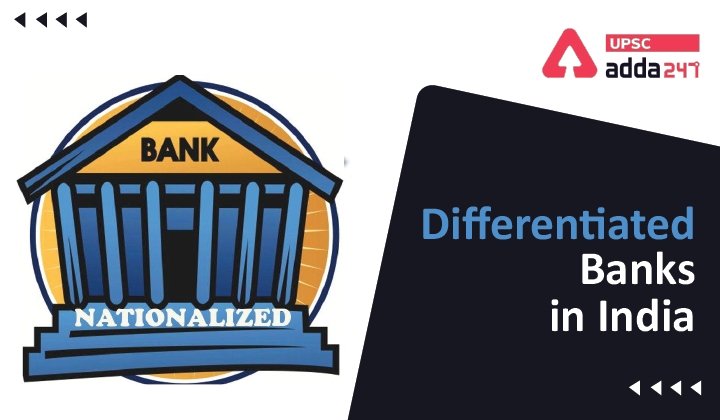Table of Contents
Differentiated banks UPSC
What are differentiated banks?
- Differentiated banks are banking institutions that are licensed by RBI to provide specific banking services and products.
- Differentiated banks are distinct from universal banks as they function in a niche segment.
- One of the major objectives to create differentiated banks is to promote financial inclusion and payments.
Differentiated bank in India
- In 2014, the Nachiket Mor Committee mooted the idea of these differentiated banks as a means to further inclusion.
- Based on the recommendations, the differentiated banking approach was introduced by RBI in 2014 with the introduction of small finance and payments banks.
Prospects of differentiated bank in India
- India provides diverse opportunities in the banking sector could be utilized by niche banking by facilitating specialization thereby enhancing optimal use of resources.
- Each of the niches has the potential to be individually large to sustain significant balance sheets and specialized entities can play a major role in all of them
- Presently, while the banking sector is evolving depending on the needs of the economy, it is felt that given a choice, some banks and non-bank financial companies may choose to operate as a specialized niche bank to derive the obvious advantages of lower absolute capital requirements, lower cost of funds and specialization.
Need for differentiated banks
- To broaden the policy goal of financial inclusion.
- Tailor made financial solution to cater various sections of society.
- They are niche banks that focus and serve the needs of a certain demographic segment of the population.
- Provision of small saving schemes to inculcate saving culture.
- Payment services.
List of Differentiated banks in India
- SMALL FINANCE BANKS
- INDIA POST PAYMENT BANKS
- LOCAL AREA BANKS
- PAYMENT BANKS
- WHOLESALE BANKING
- REGIONAL RURAL BANK
Differentiated banks advantages
- Financial Inclusion: Banks like Small finance banks and payment banks have managed to stick to their stated objective of improving financial inclusion.
- Asset growth: RBI, in its study, reported that between financial years 2017-18 and 2019-20, assets of small finance banks have grown 150% annually.
- Rise in Deposits: Small finance banks have also seen a significant rise in their deposit base. This increased deposit is enhancing the credit discipline of these banks.
- Increase in Spread: There has been a significant rise in the number of Payment Banks and small finance bank branches, thus enduring the last-mile connectivity.
- Increase in competition among banks could lower costs of transactions.
- Reduced conflict of interest: Issues of conflict of interest when a bank performs multiple functions would not arise, where differentiated licenses are issued.
Differentiated banks challenges
- Managing public perception: One of the major challenges that are faced by the differentiated banks is to build trust in the minds of depositors. Moreover, with the ever increasing presence of commercial banks in the country, it is a challenge to provide enough confidence to the public to enable them to place deposits in differentiated banks.
- Asset Liability mismatches: Sector-specific banks run the risk of asset-liability mismatches. It is one of the core reasons of the RRBs amalgamation.
- Absence of cross subsidization: Universal banks function by engaging in cross-subsidizing, which means loss-making business in one segment is balanced out with earnings from another segment. This is not possible for specialized banks as they have to mandatorily function in the pre-determined segments. It, eventually, impact their revenues.
- Concentration risk: The differentiated banks will be fraught with concentration risk and a downturn in a particular sector or region can jeopardize the operations of a bank.
- Providing a level playing field in development obligations: Introducing differentiated banks takes away the level playing field which is now available to all banks uniformly where the banks are required to contribute to the priority sector obligations and other welfare measures of the Government.





 TSPSC Group 1 Question Paper 2024, Downl...
TSPSC Group 1 Question Paper 2024, Downl...
 TSPSC Group 1 Answer key 2024 Out, Downl...
TSPSC Group 1 Answer key 2024 Out, Downl...
 UPSC Prelims 2024 Question Paper, Downlo...
UPSC Prelims 2024 Question Paper, Downlo...
